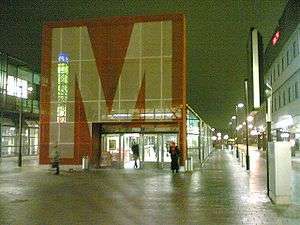East Helsinki



East Helsinki (Finnish: Itä-Helsinki, Swedish: Östra Helsingfors) is an area in Helsinki, Finland, usually thought to comprise the city's eastern and south-eastern major districts (suurpiiri in Finnish, stordistrikt in Swedish), including the districts of Vartiokylä, Myllypuro, Mellunkylä, Vuosaari, Herttoniemi, Laajasalo and Kulosaari. With the exception of Kulosaari, the buildings in the area are relatively new (most have been built in the 1960s or later) and constitute relatively densely inhabited suburbs (except the southern part of Laajasalo and most of Kulosaari).
East Helsinki has had problems with unemployment and poverty, and immigrants and refugees are somewhat concentrated in the area's subsidised housing and city-owned apartments. This has led to a popular conception of East Helsinki as a problem-ridden area, which is not necessarily true.
Public transport in East Helsinki is organised mainly through the Helsinki Metro, most of whose stops are located in the area, and feeder bus lines. Scandinavia's largest shopping centre, Itis, is located near the geographical centre of East Helsinki, and many public and commercial services for the area are concentrated there.
A major change will take place in the area's infrastructure upon the completion of the Port of Vuosaari. Most of the existing port facilities in Helsinki will be moved to the new seaport, which will create increased economic activity in East Helsinki as well as release new areas for development in other parts of the city.
Demographics
As of 2005, the eastern and south-eastern major districts of Helsinki have a combined population of 145,321, the largest single district being Mellunkylä with a population of 36,360. 10.2% of the major districts' population is of foreign origin, which is more than anywhere else in Helsinki. 84.9% of the population of East Helsinki speak Finnish as their native language. 5.4% speak Swedish, while 9.7% have another language as their mother tongue.[1] The most common languages after Finnish and Swedish are Russian, Estonian, Somali and English.[2]
The eastern major district has an unemployment rate of about 12%, more than any other major district in Helsinki, while the south-eastern major district's rate was closer to average at about 9%. Approximately one out of every ten people in East Helsinki receives social welfare payments from the Finnish state. In Mellunkylä, where the situation is the most problematic, the figure is 14.9%. (For comparison, the figure for Lauttasaari in West Helsinki is only 3.8%.)[1]
Districts
| District | Population | Area (km²) | Density (per km²) | Unempl. rate |
|---|---|---|---|---|
| Herttoniemi (Hertonäs) | 26,333 | 6.79 | 3,873 | 10.8% |
| Kulosaari (Brändö) | 3,791 | 2.47 | 1,535 | 5.7% |
| Laajasalo (Degerö) | 16,486 | 16.55 | 995 | 7.8% |
| Mellunkylä (Mellungsby) | 36,360 | 9.9 | 3,673 | 13.6% |
| Myllypuro (Kvarnbäcken) | 9,189 | 2.19 | 4,196 | 14.3% |
| Vartiokylä (Botby) | 21,214 | 7.84 | 2,662 | 10.9% |
| Vuosaari (Nordsjö) | 31,948 | 15.38 | 2,077 | 11.7% |
East Helsinki in popular culture
Many Finnish hip hop artists and groups, such as Iso H, Steen1 and Asa, come from East Helsinki. Some of them, especially Asa, employ very political themes in their music, focusing on the problems of the Finnish capital's eastern suburbs.
The Roihuvuori water tower, built in the 1970s, which is visible from most parts of East Helsinki, has become somewhat of a symbol for the area. It is used as a common device in Finnish films and TV series to signify that the events are set in East Helsinki.
References
- 1 2 Helsingin kaupungin tietokeskus, Helsinki alueittain 2005.
- ↑ Helsingin kaupungin tietokeskus, Ulkomaalaiset Helsingissä.
See also
| Wikivoyage has a travel guide for Helsinki/Inner East. |
